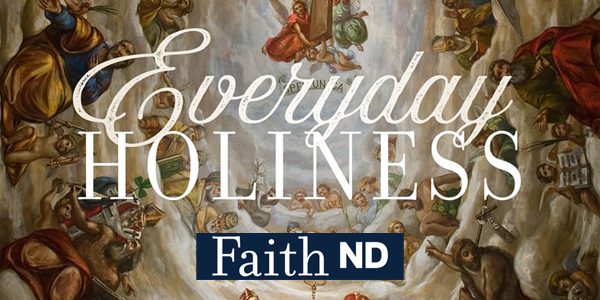Lenten Music Through the Ages – All Together Now: Sacred Music of the Baroque
Subscribe to the ThinkND podcast on Apple, Spotify, or Google.
Featured Speakers:
- J.J. Wright ’14, Director, Notre Dame Folk Choir
- Patrick Kronner, Organist and Choral Program Director at the University of Notre Dame, Director of the Magnificat Choir
In the third edition of the Rome Global Gateway’s Lenten Music Throughout the Ages, J.J Wright, Director of the University of Notre Dame Folk Choir was joined by Dr. Patrick Kronner, Organist, Director of the Magnificat Choir at the University of Notre Dame. Kronner kicked off the session by giving the audience a taste of the baroque sound on the organ. After the musical introduction, they discussed the philosophical, religious and commercial forces at play during the baroque period. Next, they spoke about “musical things”, such as the changes to music during this period in terms of sound, rhythm, singing style, ornamentation, etc. The chat ended with a question and answer, in which Kronner and Wright discussed the emotional response to sacred music.
After a quick taste of baroque music played on the organ by Kronner, the discussion began with an analysis of the philosophical, religious and commercial forces at play during the Baroque period. In 1573, the Florentine camerata began with philosophical discussions about aesthetics and a desire to emulate Ancient Greek arts. This heavily influenced baroque music in that there was a shift from Renaissance polyphony to more instrumental music. Also during the 16th century, the protestant reformation began with Martin Luther in Germany. The Bible was translated into the vernacular and there began to be an emphasis on the clarity of text in sacred music. This, in turn, changed how music was composed: there was a clean melody line with a clean text that was easy to understand and sing.
Next, Wright and Kronner spoke about the changes to music during this period. According to Wright, “this date of 1600, the baroque period, is really a watershed moment in our music, both sacred and secular, because these changes are very vast and broad” (26:00). The way music is “set up” has not changed much since this period. In fact, this was when the way we use pitches and harmonies were formalized and became standard. Kronner then used “Do a Dear” from “The Sound of Music” as an example (21:00). All modern music uses those notes (do re mi) in the same way because our modern ears like “going back to do”. Before this period (eg. gregorian chant), this was not the case. Also during this time, we can see the direct expression of text in the music. For example, in Handel’s Messiah (31:00), when the text talks about valleys and mountains, the music goes up and down to reflect the text of the song.
Lastly, Wright and Kronner responded to questions from the audience. One audience member asked whether those involved with sacred music choose pieces for the liturgy based on an expected emotional response from the congregation. Kronner noted that the differences in sacred music within the Catholic church in different parts of the world is cultural. “That’s the beauty of it: the various ways our different cultures can express the same faith [..] with different aesthetics and different musical sounds” (35:00). When planning music for a liturgy, it is important to take into account who you are trying to reach out to and their cultural background, as well as the scripture that is being read that week and the emotions it conveys. “Music is able to bypass the intellect and speak directly to the heart” (38:00).
- The baroque period was a time of vast changes in terms of music, and a lot of the changes influence our music today (26:00)
- Direct expression of text in music was a key element of the baroque period (31:00)
- Music evokes feelings and emotions (34:00, 38:00)
- “This date of 1600, the baroque period, is really a watershed moment in our music, both sacred and secular, because these changes are very vast and broad” (Wright 26:00).
- “Musical melody and harmony have this incredible capacity to evoke feelings and to point to other ideas that may not be immediately accessible” (Wright 34:25)
- “That’s the beauty of it: the various ways our different cultures can express the same faith [..] with different aesthetics and different musical sounds” (Kronner 35:00).
- “Music is able to bypass the intellect and speak directly to the heart” (38:00).
Related Content
Shannon Sharpe/Katt Williams, The Black Impact on the NFL Super Bowl & Taraji P Henson
In the first episode for Season 8, Isaiah and Tykiera talk about the Shannon Sharpe/Katt Williams Interview that took the internet by storm at the beginning of the year as well as...
watch videoEveryday Holiness: John Cavadini
Dr. John Cavadini, director of the McGrath Institute for Church Life and professor in the theology department at the University of Notre Dame, shares some of the hidden aspects...
View EventClimate Change and The Limits of Narrative
Join the Kellogg Institute for the introductory session of a workshop refining Kellogg Faculty Fellow Roy Scranton’s draft book project “Ethical Pessimism: Climate Change and...
View Event


